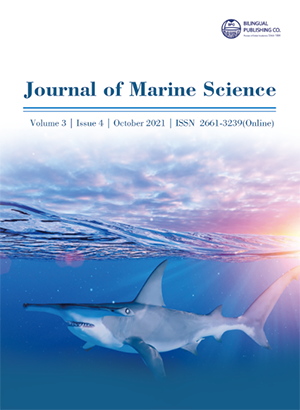Mass Beach Stranding of Blue Button Jellyfishes, Porpita porpita (Linnaeus 1758) from the Coast of Mandvi, Kutch, India during August, 2021
DOI:
https://doi.org/10.30564/jms.v3i4.3851Abstract
Present short communication reports about beach stranding of Porpita porpita (Linnaeus 1758) from the Coast of Mandvi, Kutch during August 2021. Also, this is the first record of the blue button jellyfishes for the northern Gulf of Kutch region. A study was carried out by primary observation and measurements of common environmental parameters such as Sea Surface Temperature (SST), Wind Direction & Wind Speed. Aboral and oral parts were observed and described. It is assumed that the large biomass of blue button jellyfish on the beach is due to strong shoreward Monsoon winds.
Keywords:
Porpita porpita, Mandvi-Kutch, Northern Gulf of Kutch, Beach stranding, Jelly fish, Hydrozoan, Blue buttonReferences
[1] Chowdhury M S N, Sharifuzzaman S M et al. (2016). First Record of Porpita porpita (Cnidaria: Hydrozoa) from the coral reef ecosystem, Bangladesh. Ocean Sci J., 51 293-297.
[2] Pandya KM, Parikh KV et al. (2013). Occurrence of Hydrozoans from the Saurashtra Coast of Gujarat, India. Res J Mar Sci., 1(4):1-3.
[3] Sahu B K, Baliarsingh S K et al. (2020). Mass beach stranding of blue button jellies (Porpita porpita, Linnaeus, 1758) along Odisha coast during summer season. Indian J Mar Sci., Vol. 49 (06), pp. 1093-1096.
[4] Apte D, Bhave V et al. (2012). A preliminary report on diversity of coastal ecosystems of Maharashtra, part 3: ecologically sensitive coastal areas of Ratnagiri, Rajapur and Vijaydurga. Mumbai J. Bombay Nat. Hist. Soc., 173 pp.
[5] Vaghela A, Bhadja P et al. (2010). Seasonal variations in the water quality, diversity and population ecology of intertidal macrofauna at an industrially influenced coast. Water Sci. Technol., 61(6), 1505.
[6] Dave CS. (2011). Ecological assessment of Narara reef with special reference to coral community, PhD thesis, submitted to The Maharaja Sayajirao University of Baroda.
[7] Parasharya D, Padate G. (2013). Status of Scleractinian Corals of Narara Reef in the Gulf of Kachchh, Western India. Jalplavit Vol. 4, No. 3, December-2013 (ISSN 2321-1881)
[8] CMFRI. (July-September 2010). Unusual occurrence of Porpita porpita in Aadri beach, Gujrat. CMFRI Neswletter 126, 1-23.
[9] Edwards M and Richardson AJ. (2004). Impact of climate change on marine pelagic phenology and trophic mismatch., Nature 430, 881-884.
[10] Richardson A, Schoeman D. (2004). Climate Impact on Plankton Ecosystems in the Northeast Atlantic., SCIENCE VOL 305.
[11] Oiso N, Fukai K et al. (2005). Jellyfish dermatitis caused by Porpita pacifica, a sign of global warming? Contact Points—, Contact Dermatitis 52, 232-233.
Downloads
Issue
Article Type
License
Copyright and Licensing
The authors shall retain the copyright of their work but allow the Publisher to publish, copy, distribute, and convey the work.
Journal of Marine Science publishes accepted manuscripts under Creative Commons Attribution-NonCommercial 4.0 International License (CC BY-NC 4.0). Authors who submit their papers for publication by Journal of Marine Science agree to have the CC BY-NC 4.0 license applied to their work, and that anyone is allowed to reuse the article or part of it free of charge for non-commercial use. As long as you follow the license terms and original source is properly cited, anyone may copy, redistribute the material in any medium or format, remix, transform, and build upon the material.
License Policy for Reuse of Third-Party Materials
If a manuscript submitted to the journal contains the materials which are held in copyright by a third-party, authors are responsible for obtaining permissions from the copyright holder to reuse or republish any previously published figures, illustrations, charts, tables, photographs, and text excerpts, etc. When submitting a manuscript, official written proof of permission must be provided and clearly stated in the cover letter.
The editorial office of the journal has the right to reject/retract articles that reuse third-party materials without permission.
Journal Policies on Data Sharing
We encourage authors to share articles published in our journal to other data platforms, but only if it is noted that it has been published in this journal.




 Niki Shah
Niki Shah

